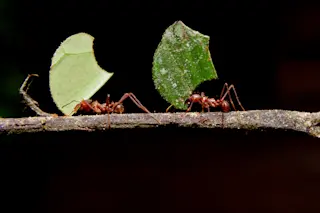“I know of no pursuit in which more zeal & important service can be rendered to any country than by improving its agriculture,” opined George Washington in a 1794 letter. While the prevalence of the frontier farmer has admittedly decreased since Washington’s day, agriculture itself is arguably one of humanity’s crowning achievements, laying the groundwork for the rise of civilization and allowing the human population to exponentially proliferate.
However, agriculture isn’t necessarily a uniquely human endeavor. Leaf cutter ants, each with a brain no larger than a pinhead, have also transitioned from hunter-gatherers to farmers — and they did it long before humans ever existed.
To the extent that ants are farmers, it's because they, along with a select few other species, cultivate their own food for consumption. Currently, over 200 ant species across the Western Hemisphere make forays into the jungle, driven by some deep-seated atavistic instinct that compels ...














